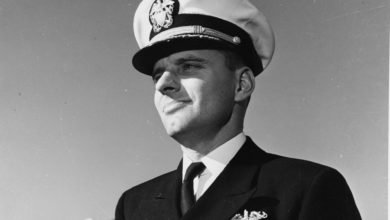Medal of Honor Monday: Army Spc. 5th Class Clarence Sasser
Army Spc. 5th Class Clarence Sasser was a part-time college student when he was drafted into the Army as a medic. He was sent to Vietnam at the height of the war and did his job so fearlessly during battle that he earned the Medal of Honor.
Sasser was born Sept. 12, 1947, and grew up in the small town of Rosharon, Texas, near Houston. He had a brother, a sister and four step-siblings who all lived on a farm with Sasser’s mother and his stepfather, a church deacon who helped raise him.
Sasser went to Marshall High School and was in one of the school’s last segregated classes. He played football and did well academically, graduating in 1965 near the top of his class.
Sasser enrolled at the University of Houston to study chemistry. He eventually switched to part-time so he could work to pay for classes, causing him to become eligible for the draft. So, when his number came up, instead of trying to gain college deferment, he joined the Army in June 1967.
Sasser trained as a medical aidman and knew pretty quickly that he would be going to Vietnam. He arrived in the country in late September 1967 when he was barely 20 years old.
Sasser hadn’t been in Vietnam for more than four months when he was put to the ultimate test as a medic with the 3rd Battalion, 60th Infantry, 9th Infantry Division.
On Jan. 10, 1968, then-Private 1st Class Sasser was with Company A on a reconnaissance mission to the Mekong River Delta to investigate reports of enemy activity. That morning, as about a dozen company helicopters were landing, they suddenly started taking heavy fire from three sides of the landing zone. A well-entrenched enemy using rockets, machine guns and small arms managed to take down 30 American fighters in the first few minutes of the attack.
“I got grazed getting off the helicopter, in the leg,” Sasser said during a Library of Congress Veterans History Project interview in 2001. “[There was] fire all around us. With the helicopter down, there wasn’t any choice. We had to go in.”
Through a hail of gunfire, Sasser ran across an open rice paddy to help his injured comrades. As he helped one soldier to safety, he was wounded again, this time in the left shoulder by fragments of an exploding rocket.
“Shell fragments are something. I’ll never forget how they feel,” Sasser recalled. “The pain sets in later. The initial shock is what you experience, and the searing — shell fragments are hot.”
Sasser ignored his injuries and ran through a barrage of rocket and automatic weapons fire to help two more men before moving on to search for others who were wounded. After suffering two more injuries that immobilized his legs, Sasser dragged himself through the mud to continue his work.
“The best way to get around that day was just simply grabbing the rice sprouts and sliding yourself along. You could move better like that. If you stood up, you were dead,” Sasser said. “The snipers would get you.”
After crawling roughly 100 meters, Sasser treated another soldier before encouraging more men to crawl 200 meters to relative safety. Once there, he treated them over the course of the night. Sasser said if it wasn’t for Air Force close air support dropping bombs to keep the enemy off them, they likely all would have died.
“We laid there that night. All you could hear was guys moaning, calling for their mama,” he remembered. “Listening to them beg all night … It was the toughest thing I’ve ever done.”
Sasser said evacuation helicopters finally came for them around 4 a.m. or 5 a.m. the next day.
“It was a relief. We were out of there, and I was still alive. I was hurting, but I wasn’t in mortal danger,” Sasser said of his feelings at that moment. “I had made it.”
Sasser was treated at a hospital before being evacuated to Japan for further recovery. During his rehabilitation, he helped out at the hospital’s dispensary, and a doctor he’d befriended was able to get him reassigned there instead of returning to Vietnam.
“To this day I thank him,” Sasser said.
It was during that assignment in the latter half of 1968 that he learned that he had earned the Medal of Honor.
“I don’t think what I did was above and beyond. I never have, and for a long time I had a problem with that,” Sasser said. “But finally … a friend helped me reconcile it to the point that it meant, ‘Hey, you did your job.'”
After transferring back to the states,, the nation’s highest honor was presented to him by President Richard M. Nixon during a White House ceremony on March 7, 1969. Two other soldiers, Army Staff Sgt. Joe Hooper and Army Sgt. 1st Class Fred Zabitosky, also received the Medal of Honor that day.
“Probably the greatest thing to me was to be in a room with [Army Maj.] Audie Murphy, [Marine Corps Col. Gregory] Pappy Boyington and [Army Gen.] Jimmy Doolittle,” Sasser said of the ceremony. “These guys I had read about — guys that I’m now in their situation or I’m in their society or their group. That, to me, was something.”
Sasser was discharged from the Army in June of 1969 and returned to his chemistry studies, this time with a scholarship to Texas A&M University. Before finishing, though, he married Ethel Morant and took a job at a petro-chemical refinery near Houston. He worked there for five years before beginning a longtime career with the Department of Veterans Affairs in Houston. He and Ethel had three boys, Ross, Benjamin and Billy.
Over the years, Sasser has given talks to schools and veterans organizations about his experiences. In 2013, he was inducted into Texas A&M’s Medal of Honor Hall of Honor. During his speech, he said how not graduating from the school was one of his biggest regrets. So, in 2014, the school gave him an honorary Doctor of Letters degree.
This article is part of a weekly series called “Medal of Honor Monday,” in which we highlight one of the more than 3,500 Medal of Honor recipients who have earned the U.S. military’s highest medal for valor.
Source: Department of Defense
Content created by Conservative Daily News is available for re-publication without charge under the Creative Commons license. Visit our syndication page for details.




